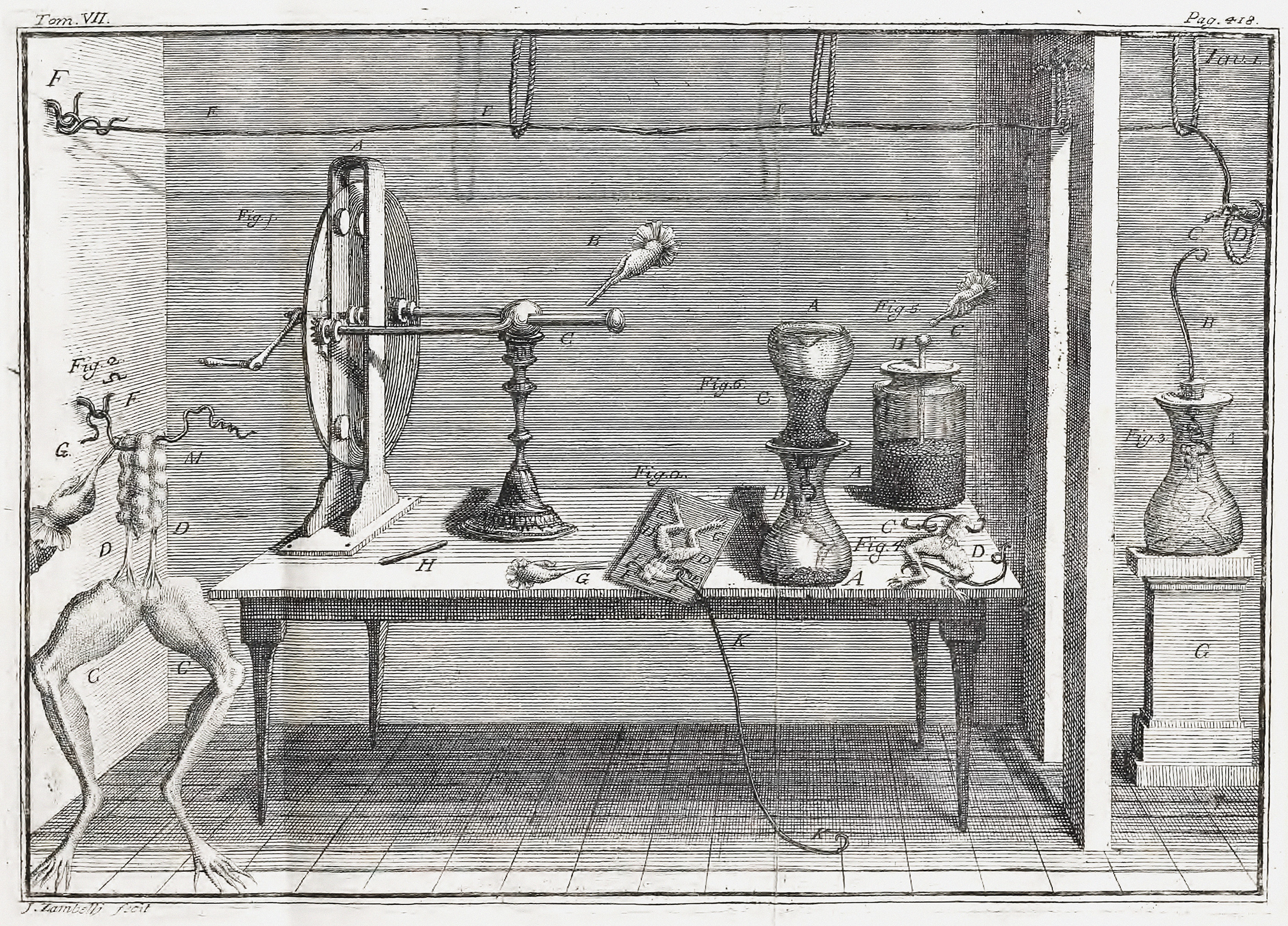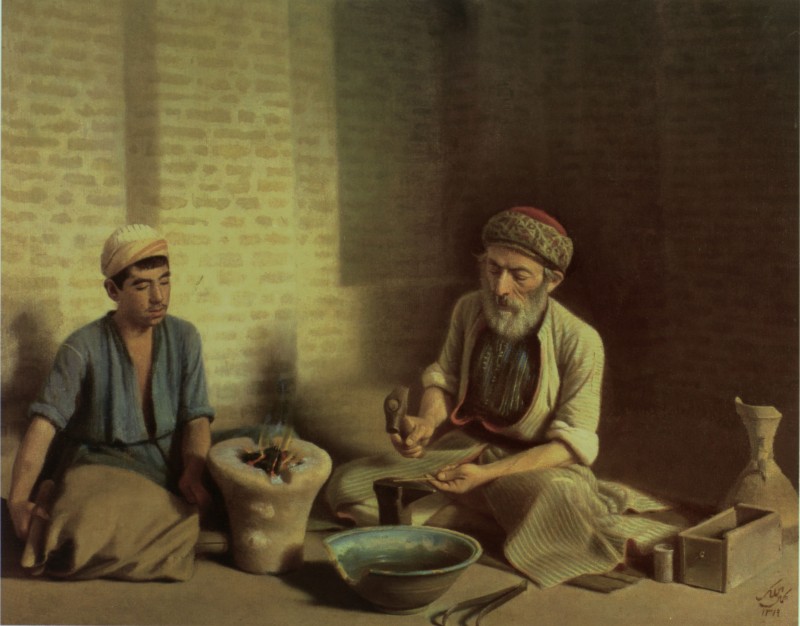|
Luigi Galvani
Luigi Galvani ( , , ; ; 9 September 1737 – 4 December 1798) was an Italian physician, physicist, biologist and philosopher who studied animal electricity. In 1780, using a frog, he discovered that the muscles of dead frogs' legs twitched when struck by an electrical spark. This was an early study of bioelectricity, following experiments by John Walsh (scientist), John Walsh and Hugh Williamson. Early life Luigi Galvani was born to Domenico Galvani and Barbara Caterina Foschi, in Bologna, then part of the Papal States. The house in which he was born may still be seen on Via Marconi, 25, in the center of Bologna. Domenico was a goldsmith. His family had produced several illustrious men. Galvani then began taking an interest in the field of "medical electricity". This field emerged in the middle of the 18th century, following electrical researches and the discovery of the effects of electricity on the human body by scientists including Bertrand Bajon and Ramón María Termey ... [...More Info...] [...Related Items...] OR: [Wikipedia] [Google] [Baidu] |
Animal Electricity
Galvanism is a term invented by the late 18th-century physicist and chemist Alessandro Volta to refer to the generation of electric current by chemical action. The term also came to refer to the discoveries of its namesake, Luigi Galvani, specifically the generation of electric current within biological organisms and the contraction/convulsion of biological muscle tissue upon contact with electric current. While Volta theorized and later demonstrated the phenomenon of his "Galvanism" to be replicable with otherwise inert materials, Galvani thought his discovery to be a confirmation of the existence of "animal electricity," a vital force which gave life to organic matter. History Johann Georg Sulzer Galvanic phenomena were described in the literature before it was understood that they were of an electrical nature. In 1752, when the Swiss mathematician and physicist Johann Georg Sulzer placed his tongue between a piece of lead and a piece of silver, joined at their edges, he per ... [...More Info...] [...Related Items...] OR: [Wikipedia] [Google] [Baidu] |
Galvani Frog Legs Experiment Setup
Luigi Galvani ( , , ; ; 9 September 1737 – 4 December 1798) was an Italian physician, physicist, biologist and philosopher who studied animal electricity. In 1780, using a frog, he discovered that the muscles of dead frogs' legs twitched when struck by an electrical spark. This was an early study of bioelectricity, following experiments by John Walsh (scientist), John Walsh and Hugh Williamson. Early life Luigi Galvani was born to Domenico Galvani and Barbara Caterina Foschi, in Bologna, then part of the Papal States. The house in which he was born may still be seen on Via Marconi, 25, in the center of Bologna. Domenico was a goldsmith. His family had produced several illustrious men. Galvani then began taking an interest in the field of "medical electricity". This field emerged in the middle of the 18th century, following electrical researches and the discovery of the effects of electricity on the human body by scientists including Bertrand Bajon and Ramón María Termey ... [...More Info...] [...Related Items...] OR: [Wikipedia] [Google] [Baidu] |
A History Of The Theories Of Aether And Electricity
''A History of the Theories of Aether and Electricity'' is any of three books written by British mathematician Sir Edmund Taylor Whittaker FRS FRSE on the history of electromagnetic theory, covering the development of classical electromagnetism, optics, and aether theories. The book's first edition, subtitled ''from the Age of Descartes to the Close of the Nineteenth Century'', was published in 1910 by Longmans, Green. The book covers the history of aether theories and the development of electromagnetic theory up to the 20th century. A second, extended and revised, edition consisting of two volumes was released in the early 1950s by Thomas Nelson, expanding the book's scope to include the first quarter of the 20th century. The first volume, subtitled ''The Classical Theories'', was published in 1951 and served as a revised and updated edition to the first book. The second volume, subtitled ''The Modern Theories (1900–1926)'', was published two years later in 1953, exten ... [...More Info...] [...Related Items...] OR: [Wikipedia] [Google] [Baidu] |
Electrochemical Cell
An electrochemical cell is a device that either generates electrical energy from chemical reactions in a so called galvanic cell, galvanic or voltaic cell, or induces chemical reactions (electrolysis) by applying external electrical energy in an electrolytic cell. Both galvanic and electrolytic cells can be thought of as having two half-cells: consisting of separate Redox, oxidation and reduction reactions. When one or more electrochemical cells are connected in parallel or series they make a Battery (electricity), battery. Primary battery consists of single-use galvanic cells. Rechargeable batteries are built from #Secondary cells, secondary cells that use reversible reactions and can operate as galvanic cells (while providing energy) or electrolytic cells (while charging). Types of electrochemical cells Galvanic cell A galvanic cell (voltaic cell), named after Luigi Galvani (Alessandro Volta), is an electrochemical cell that generates electrical energy from spontaneous ... [...More Info...] [...Related Items...] OR: [Wikipedia] [Google] [Baidu] |
Membrane Potential
Membrane potential (also transmembrane potential or membrane voltage) is the difference in electric potential between the interior and the exterior of a biological cell. It equals the interior potential minus the exterior potential. This is the energy (i.e. work) per charge which is required to move a (very small) positive charge at constant velocity across the cell membrane from the exterior to the interior. (If the charge is allowed to change velocity, the change of kinetic energy and production of radiation must be taken into account.) Typical values of membrane potential, normally given in units of milli volts and denoted as mV, range from −80 mV to −40 mV. For such typical negative membrane potentials, positive work is required to move a positive charge from the interior to the exterior. However, thermal kinetic energy allows ions to overcome the potential difference. For a selectively permeable membrane, this permits a net flow against the gradient. This is a kind ... [...More Info...] [...Related Items...] OR: [Wikipedia] [Google] [Baidu] |
University Of Pavia
The University of Pavia (, UNIPV or ''Università di Pavia''; ) is a university located in Pavia, Lombardy, Italy. There was evidence of teaching as early as 1361, making it one of the List of oldest universities in continuous operation, oldest universities in the world. It was the sole university in Milan and the greater Lombardy region until the end of the 19th century. In 2022, the university was recognized by the Times Higher Education World University Rankings, Times Higher Education among the top 10 in Italy and among the 300 best in the world. Currently, it has 18 departments and 9 faculties. It does not have a main campus; its buildings and facilities are scattered around the city, which is in turn called "a city campus". The university caters to more than 20,000 students who come from Italy and all over the world. The university offers more than 80 undergraduate programs; over 40 master programs, and roughly 20 doctoral programs (including 8 in English). About 1,500 studen ... [...More Info...] [...Related Items...] OR: [Wikipedia] [Google] [Baidu] |
Alessandro Volta
Alessandro Giuseppe Antonio Anastasio Volta (, ; ; 18 February 1745 – 5 March 1827) was an Italian chemist and physicist who was a pioneer of electricity and Power (physics), power, and is credited as the inventor of the electric battery and the discoverer of methane. He invented the voltaic pile in 1799, and reported the results of his experiments in a two-part letter to the president of the Royal Society, which was published in 1800. With this invention, Volta proved that electricity could be generated chemically and debunked the prevalent theory that electricity was generated solely by living beings. Volta's invention sparked a great amount of scientific excitement and led others to conduct similar experiments, which eventually led to the development of the field of electrochemistry. Volta drew admiration from Napoleon Bonaparte for his invention, and was invited to the Institute of France to demonstrate his invention to the members of the institute. Throughout his life, ... [...More Info...] [...Related Items...] OR: [Wikipedia] [Google] [Baidu] |
Journal Of The History Of Medicine And Allied Sciences
A journal, from the Old French ''journal'' (meaning "daily"), may refer to: *Bullet journal, a method of personal organization *Diary, a record of personal secretive thoughts and as open book to personal therapy or used to feel connected to oneself. A record of what happened over the course of a day or other period *Daybook, also known as a general journal, a daily record of financial transactions *Logbook, a record of events important to the operation of a vehicle, facility, or otherwise * Transaction log, a chronological record of data processing * Travel journal, a record of the traveller's experience during the course of their journey In publishing, ''journal'' can refer to various periodicals or serials: *Academic journal, an academic or scholarly periodical **Scientific journal, an academic journal focusing on science ** Medical journal, an academic journal focusing on medicine **Law review, a professional journal focusing on legal interpretation *Magazine, non-academic or s ... [...More Info...] [...Related Items...] OR: [Wikipedia] [Google] [Baidu] |
Ramón María Termeyer
Ramón María Termeyer (2 February 1737 – c. 1815) was a Jesuit naturalist who lived in South America. He conducted experiments on silk including those from silkworms and spiders, plants, and electric eels. Following the Suppression of the Society of Jesus, he retired to live in Italy where he continued his research and writing. Life and work Termeyer was born in Cadiz and came from a family of Dutch descent. He joined the Society of Jesus in Andalusia on October 11, 1755 and in 1763 he was ordained in Serville. In 1764 he joined Father Juan de Escandón (1696-1772) to Buenos Aires. He travelled to Córdoba and then moved to the Rio de la Plata carrying with him silkworm eggs and mulberry seeds. He conducted experiments with silkworms and went to Paraguay to establish sericulture. Unable to grow mulberry, the silkworm experiments failed. He then worked with Florian Paucke in San Javier close to the Paraná River. Here he conducted experiments on electric eels and spider sil ... [...More Info...] [...Related Items...] OR: [Wikipedia] [Google] [Baidu] |
Goldsmith
A goldsmith is a Metalworking, metalworker who specializes in working with gold and other precious metals. Modern goldsmiths mainly specialize in jewelry-making but historically, they have also made cutlery, silverware, platter (dishware), platters, goblets, decorative and serviceable utensils, and ceremonial or religious items. Goldsmiths must be skilled in forming metal through file (tool), filing, brazing, soldering, sawing, forging, Casting (metalworking), casting, and polishing. The trade has very often included jewelry-making skills, as well as the very similar skills of the silversmith. Traditionally, these skills had been passed along through apprenticeships; more recently jewelry arts schools, specializing in teaching goldsmithing and a multitude of skills falling under the jewelry arts umbrella, are available. Many universities and junior colleges also offer goldsmithing, silversmithing, and metal arts fabrication as a part of their fine arts curriculum. Gold Compar ... [...More Info...] [...Related Items...] OR: [Wikipedia] [Google] [Baidu] |







